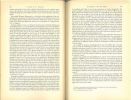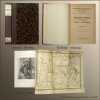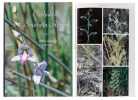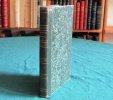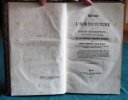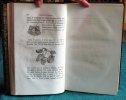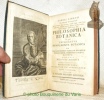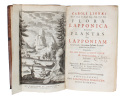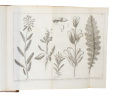-
Type
Autograph (1)
Book (8371)
Engraving (1)
Magazine (50)
Photographs (1)
-
Latest
Last 3 days (1)
Last month (227)
Last week (24)
-
Language
Dutch (4)
English (14)
French (8393)
German (2)
Italian (1)
Japanese (2)
Latin (4)
Polish (1)
Portuguese (1)
Russian (1)
Spanish (1)
-
Century
16th (12)
17th (23)
18th (263)
19th (1522)
20th (3726)
21st (387)
-
Countries
Belgium (160)
Canada (21)
China (2)
Côte d'Ivoire (15)
Denmark (296)
France (7016)
Italy (56)
Spain (71)
Switzerland (787)
-
Syndicate
ALAC (21)
CLAM (10)
CLAQ (21)
CNE (3)
ILAB (3732)
NVVA (266)
SLACES (266)
SLAM (2793)
SNCAO (23)
Les maladies à virus des plantes.
1941 Paris, Imprimerie Nationale, 1941 : in-8, relié 88 pp., demi-toile rouge, pièce de titre en cuir noir. Très bon état, cachet de bibliothèque en page de titre !
Botanische Reisen in den Hochgebirgen Chinas und Ost-Tibets.
Dahlem bei Berlin, Verlag des Repertoriums, 1922. 8°. VIII, 515 S. Mit 30 Abb. auf 16 Tafeln und 9 Karten (davon 8 gef.). Halbleinenband der Zeit (leicht berieben und bestossen, mit Bibliotheksrückenschild).
Durchgehend gebräunt.
Musci Asiae Borealis. Beschreibung der von den Schwedischen Expeditionen nach Sibirien in den Jahren 1875 und 1876 gesammelten Moose mit Berücksichtigung aller früheren bryologischen Angaben für das Russische Nord-Asien. Erster Theil. Lebermoose. Zweiter Theil. Laubmoose.
1889-1890 69, 163 p., 4to, modern blue cloth (with paper label on spine). Kongl. Svenska Vetenskaps-Akademiens Handlingar. Ex library F. Verdoorn (with his library stamps). Scarce.Frans Verdoorn (1906-1984) was a Dutch botanist specialized in Bryophytes, publisher, and a scientist who coined the term biohistory.
LINDEN, J., & Lucien, Rodigas, Em., and Rolfe, R. A.(conducted by):
Reference : 135593aaf
Lindenia. Iconography of Orchids. Director: J. Linden. Editors-in-chief: Lucien Linden & Émile Rodigas in collaboration with eminent specialists.Linden,Jean [Jules]. (director). A 5 volume set.
Gand, Imprimerie Eug. Vanderhaeghen, 1885-1906. [Reprint Turriers, Naturalia Publications (S.A. Transfaire), 1993, in-4to, En 5 volumes. 475, 474, 505, 505, 519, pp. 814 col. plts. Uniform cloth, + dustjacket (Fine new copy).
Complete reprint set of the first English edition in five volumes: Vol. 1: 1885 - 1888; Vol. 2: 1888 - 1891; Vol. 3: 1891 - 1894; Vol. 4: 1894 - 1898; Vol. 5: 1898 - 1906. - Famous Belgian publication "Lindenia: iconographie des orchide es", issued as periodical between 1885-1906 by the publisher E. Vanderhaeghen.

(SLACES, NVVA)
Phone number : 41 (0)26 3223808
Les orchidées exotiques et leur cultures en Europe.
Bruxelles; Paris, chez l'auteur; Octave Doin, 1894. Grand in-8 de XIV-1019-[1] pages, demi-basane rouge, dos lisse orné de filets dorés, mors et coiffes épidermés, un mors fragile.
Illustré d'un portrait de l'auteur, et de 141 planches gravées sur bois, parfois à pleine page.
Autoecologisch onderzoek aan Sargassum muticum (Yendo) Fensholt in het Grevelingenmeer en inventarisatie van deze alg in Nederland.
1984 214 p., 55 figures, 4to, paperbound (unsewn). Onesided thesis. Scarce.
Linder, H(ans) P(eter) u. Kurzweil, H.:
Reference : 6449CB
(1999)
ISBN : 90-5410-445-7
Orchids of Southern Africa.
Rotterdam, Balkema, 1999. XII, 492 S. Mit zahlr. Tafeln mit total 500 farb. Abb. und zahlr. Textillustr. Orig.-Leinenband mit farb. Schutzumschlag.
Mit Beiträgen von A.V. Hall, C. Hilton-Taylor, K. Immelman, S.D. Johnson, J. Manning, E.A. Schelpe, K.E. Steiner, L. Vogelpoel und K.H.K. Wodrich.
An Introduction to Botany. Third ed.
London, Longman etc., 1839. Cont. hcalf. Gilt back. X,594 pp., 6 engraved plates, many textillustr.
Ladies' Botany: or a Familiar Introduction To the Study of the Natural System of Botany. Sixth ed. 2 vols.
London, Henry G. Bohn, 1865. 8vo. 2 orig. full green cloth. Richly gilt backs. 2 corners bumped. 2 cm. of upper part of first title cut away, no loss of text. Uncut. First title browned, otherwise clean and fine. XV,300,VIII,279 pp. and 50 handcoloured engraved plates. One plate torn, but repaired.
BMC NH III: 1120.
Théorie de l'Horticulture - Édition originale.
Ou Essais Descriptifs, selon les principes de la Physiologie, sur les principales Opérations Horticoles. Par John Lindley (1799-1865).4 planches gravées hors texte de Acarie-Baron et figures dans le texte.Livre premier. Des principaux faits relatifs à la vie végétale qui expliquent les opérations de l'horticulture. Germination - De la croissance par les racines - De la croissance par la tige - Fonctions des feuilles - Fonctions des fleurs - De la maturation du fruit - De la température .Livre II. Des principes physiologiques dont dépendent essentiellement les opérations horticulturales. De la chaleur artificielle - De l'humidité du sol - Des arrosements - De l'humidité et de la température atmosphérique - De la ventilation - Du semis des graines - De la conservation des graines - de l'emballage des graines - De la multiplication par yeux et par noeuds - De la multiplication par feuilles - De la multiplication par boutures - De la multiplication par marcottes et par rejetons - De la multiplication par inoculation et par greffe - De la taille - Du palissage - De l'empotage - De la transplantation - De la conservation des races par la graine - De l'amélioration des races - Du repos des plantes - Du sol et des engrais - Table analytique des matières.Édition originalefrançaise. Paris, H. Cousin 1841 - 434 pages et Extrait du Catalogue de la Librairie de H. Cousin in fine.Reliure demi veau glacé vert de l'époque. Dos lisse à faux nerfs filetés dorés. Quelques rousseurs. Menus frottements. Bon exemplaire, bon état. Format in-8°(24x16).
ACARIE-BARON
Aphorismes de physiologie végétale et de botanique, suivis du tableau des alliances des plantes et de l'analyse artificielle des ordres.
1838 [6], 180 p., paperbound (original printed covers, outer ends spine somewhat worn). Some slight foxing throughout. Unopened copy. Very rare French translation of ''A key of structural, physiological and systematical botany'' and of various bits of other of his writings. Not in Cat. Library BMNH and seldom offered for sale.
Atlas der mikroskopischen Grundlagen der Gärungskunde mit besonderer Berücksichtigung der biologischen Betriebskontrolle.
1903 (1st ed.) 9, [4] p., 111 pls, cloth (front cover somewhat discoloured). Ex libris J. Nash-Wortham.
Le Monde Des Arbres : La Vie Des Bois et Des Forêts
Paris AUDUBON / Larousse 1981 Grand In 8 Traduction de Dominique Le Bourg . Au sommaire : La forêt tropicale - landes arborées et savanes - les forêts -galeries - les arbres extraordinaires - les forêts tempérées humides - les eucalyptus d'Australie - les forêts de feuillus - la forêt boréale - les forêts froides - les forêts sèches . Notices biographiques des photographes . Index . Illustré de superbes photographies en couleurs . - 264 p. , 2 kg 600 gr.
Couverture rigide Parfait État . Perfect State . Jaquette Idem 1° Édition En Français
LE MONDE DES FLEURS SAUVAGES
HACHETTE. 1979. In-4. Relié. Bon état, Couv. convenable, Dos satisfaisant, Intérieur frais. 256 pages illustrées de nombreuses photos dans le texte et hors texte.. . . . Classification Dewey : 580-Botanique
Classification Dewey : 580-Botanique
Hortus Regius Botanicus Berlolinensis descriptus. Tomus I (of 2).
Berlin, G. Reimer, 1827. Cont. hcalf. Richly gilt back. Back with scratches and a little rubbes. VIII,384 pp.
Zur Kenntnis der Ueberwinterung der Unkräuter und Ruderalpflanzen in der Gegend von Helsingfors.
Helsingfors, o. Vlg., 1922. Gross-8°. S. 91-228. Mit 25 Textabb. Orig.-Broschur (Rücken gebräunt u. mit kl. restaurierten Einrissen). = "Suomalaisen eläin- ja kasvitieteellisen seuran vanamon jukaisjua" bzw. Annales societatis zoolog.-botanicae fennicae vanamo", Bd. 1, Nr. 7.
Mit handschriftl. Widmung von K. Linkola auf dem Einband. - Vord. Einbanddeckel u. Titelseite mit handschriftl. Eintrag u. Bibliotheksstempel.
Species plantarum, exhibentes plantas rite cognitas ad genera relatas cum differentiis specicficis, nominibus, trivialibus, synonymis selectis, locis natalibus, secundum Systema Sexuale digestas. Tomus II.-
Edition Tertia. Vindobonae (Vienne). Joannis Thomae de Trattner.. 1764. In-8 (125 x 205mm) pleine basane racinée de l'époque, dos à 5 nerfs très orné, pièces de titre et de tomaison maroquin rouge, tranches rouges, 1f. et pages 785 à 1682, puis 33ff.n.ch. (index et errata). Reliure un peu frottée mais bel exemplaire. Attention tome II et dernier SEUL.
Philosophia Botanica in qua Explicantur Fundamenta Botanica cum Definitionibus Partium, Exemplis Terminorum, Observationibus Rariorum. Adiectis Figuris Aeneis. Editio secunda in Gratiam Botanophilorum Revisa et Emendata. Curante D. Johanne Gottlieb Gleditsch.
Berolini - Berlin, Impensis Christiani Friderici Himburgi 1780, 203x125mm, cartonnage de l’époque, étiquette de titre manuscrite au dos, en parti manquante, nom ancien de possesseur sur page de garde, intérieur propre.
frontispice, 3 ff., 362 pages, 11 planches gravées dépliantes, Pour un paiement via PayPal, veuillez nous en faire la demande et nous vous enverrons une facture PayPal
Collection of 4 papers on Linnaeus's work: Stearn, 1957. An Introduction to the Species Plantarum and cognate botanical works of Carl Linnaeus (xiv, 176 p., unbound).
1938-1957 Sprague, 1955. The plan of the Species Plantarum (16 p., stapled); Savage, 1938. Exhibition of a selection from Linnaeus collections and the Society's archives (20 p., wrps) & Ramsbottom, 1938. Linnaeus and the Species Concept (29 p., wrps).
Anmärkningar öfwer Amaryllis den Sköna.
Stockholm, 1742. 8vo. Senere papirsomslag. Udsnit af Kungl. Vetenskaps Academiens Handlingar 1742. Apr. Maj. Jun. Pp. 93-102 samt 1 stor foldet kobberstukket planche
The paper contains Linné's original description of Amaryllis belladonna with the large plate showing its successive growth.
Bibliotheca Botanica. Recensens libros plus mille de plantis huc usque editos, secundum systema auctorum naturale in classes, ordines, genera et species dispositos, additis editionis loco, tempore, forma, lingua caet. Pars 1Edito Nova Multo Correctior. - [THE FIRST BOTANICAL BIBLIOGRAPHY ARRANGED BY SUBJECT]
Halae Sailcae [i.e. Stockholm]: Apud Io. Gottl. Bierwirth, 1747. 8vo. Contemporary marbled paper binding with handwritten paper label to spine. Occational signs of wear. Overall a very nice copy. [XIV], 124, [8] pp.
Second edition of Linnaeus' important ""Bibliotheca Botanica"" (without the Fundamentorum Botanica, which appeared simultaneously), his highly important, elaborate classification system for his catalogue of books. This significant work constitutes the first botanical bibliography arranged by subject and the work in which the term ""methodists"" is coined. ""The Bibliotheca is a concise history of botany in a dry, enumerative, but very efficient style. Linnaeus describes the development of botanical science by subdividing the authors in various categories and by adding several statements on the main events in human affairs without which the growth of botany as a science cannot be understood. The often enlightening and amusing names for the various categories of botanists show not only a good knowledge of the literature, but also an awareness of the fact that botanical history is human history."" (Frans Stafleu).The ""Bibliotheca Botanica"" is complete in itself. It was contemplated as the first part of a planned Bibliotheca medica (which he never wrote). It first appeared in 1736, and the present second edition constitutes a reprint of the first edition of the text, with the addenda and errata of Linnaeus inserted in their place. The work appeared again in 1751. Soulsby: 251.
Tal, om Märkwärdigheter uti insecterne, hållt för Wettenscaps Academien uti Auditorio Illustri på första Præsidentskapet aflades 1739. D. 3. October. - [LINNAEUS' VIEW OF NATURE]
Stockholm, Pet. Momma, 1739. Small 8vo. Preserved in covers of older blindstamped golden paper. Title-page a bit soiled and with old owner's names (one of them crossed out, the other one being Roland Martin). A small restoration to lower blank margin of title-page. Woodcut initial at beginning and woodcut end-vignette. (18) pp.
Exceedingly rare first edition, first issue (with an excellent provenance) of Linnaeus' seminal speech which has gone down in history as one of the most famous and influential summations on the economy of nature - demonstrated by ""curiosities among insects"". With poetical eloquence, Linnaeus shows us the wonder of the small creature that is the insect and beautifully ties together the nature of the world that we live in, providing to all living things a means and an end. Published merely four years after the groundbreaking first edition of the ""Systema Natura"" - and two decades before the definitive 10th edition of it - Linnaeus, in this epochal speech, points us to the fact that only with the ""Systema Natura"" had the true nature of the insect been discovered, revealing to us also the true wonder of nature. This groundbreaking speech was given at the inauguration of the Royal Academy of Sciences in Stockholm in 1739. Linnaeus himself was one of the founders of the academy"" this foundational speech not only marks the beginning of the world-changing Academy of Sciences, being the first in a long series of presiding speeches that were given four times a year (when the Academy chose a new chairman), it also marks an epoch in the theory of natural history. The frequent reprinting of the speech bears witness to its epochal character and the importance it came to hold for Linnaeus himself. The extremely scarce first issue was printed by Momma in a poor antiqua setting, mixing three different styles, and the last three pages are in a smaller font. New issues appeared in Swedish in 1747 and 1752, the speech was reprinted in Latin numerous times in different issues of the ""Amoenitates"", and it was translated into English and German. When occupying oneself with the greatest modern zoologist, Carl von Linné, the founder of binominal nomenclature, one rarely comes across references to his philosophical theory of the world. Unlike many modern thinkers, 18th century scientists and philosophers did not find the notion of God as ruler of the Universe incompatible with hard scientific facts. On the contrary, the relationship between God and Nature was an issue of crucial importance to many natural scientists of the period. The present speech constitutes the most important declaration of Linnaeus' thoughts on the subject, presenting him as what we would call a ""physicotheologist"". By means of the ""curiosities among insects"", Linnaeus here presents Nature as a single, self-regulating global entity - an entity that is a wonder created by God. The present publication constitutes one of the most personal works that Linnaeus ever wrote and provides with a direct insight into his entire world view - the view of the world that enabled us to properly classify and systematize all living things. It is not least due to the present work that Linnaeus was so widely admired by the greatest of his contemporaries. In his own time he was not only admired for his great scientific accomplishments, he became famous for wider cultural reasons and for the moral qualities that understream his scientific work. That is the main reason why he was considered a hero by the likes of Rousseau and why the likes of Goethe made debating Linnaeus a pastime in fashionable Romantic circles. The work is of the greatest scarcity. OCLC lists merely six copies in libraries world-wide, two of which are in the US: Kansas State University and North Carolina State University. The remaining four copies are in: Sweden, France, UK, and The Netherlands. ROLAND MARTIN (1726-1788) was prominent physician, who was a student of Linnaeus. He studied at the University of Uppsala and here defended his dissertation in 1745 (under Linnaeus). He was nominated professor of medicine twice, but refused both times. He was considered an excellent teacher and a great physician, but he was a controversian man and caused dramatic debacle when he left the Collegium medicum and joined the Societas chirurgica (only to return in 1766, with a tarnished reputation). Hult, p. 31-32.BMC 3141Soulsby 1341
"LINNAEUS (LINNÉ), CARL. - ""WAITED FOR EXPECTANTLY"" AND ""RECEIVED WITH ACCLAIM"".
Reference : 49368
(1737)
Flora Lapponica exhibens Plantas per Lapponiam Crescentes, secundam Systema Sexuale Collectas in Itinere... Additis Synonymis, & Locis Natalibus Omnium, Descriptionibus & Figuris Rariorum, Viribus Medicatis & Oeconomicis Plurimarum.
Amsterdam, Salomonem Schouten, 1737. 8vo. Contemporary full mottled calf. Light wear to top of spine. Light wear along fronthinge. Raised bands. Richly gilt compartments. Titlelabel in leather with gilt lettering. Engraved frontispiece. Titlepage in red/black. (40),372,(38) pp. and 12 folded engraved plates. Printed on good paper. Internally clean and fine.
Scarce first edition of this highly important work, which is one of the first in which Linné worked out his binomial nomenclature, being of ""prime importance for the nomenclature of Arctic-Alpine species"".On May 12th 1732, Linnaeus set out on his journey into Lapland, returning to Uppsala on October 10th, after adventures in snow and sleet, discovering 'novelties in all three kingdoms of nature', including many new plants. All this he recorded in diary and catalogue... Linnaeus worked on the present volume during his sojourn in Leyden and at the Clifford estate at Hartecamp in Holland. A Society was formed at Amsterdam to defray the expenses of the plates.., and the 'Flora Lapponica' came forth in 1737, just ahead of the 'Geneve plantarum' and the 'Hortus Cliffortianus'. Botanists had waited for it expectantly, and they received it with accaim. (Hunt No. 502).""The journey was the most adventurous that Linnaeus ever made" it has been assessed by his fellow-countrymen as the most fruitful single scientific expedition ever made in Sweden both for its immediate botanical results and its influence on Linnaeus's later career. It led to the publication in 1737 of his Flora Lapponica which is of prime importance for the nomenclature of Arctic-Alpine species" Linnaeus's Lapland specimens, on which this was based, are in Paris."" (The Linnaean Correspondance).Hulth: p. 21 - Soulsby: No. 279.
Système sexuel des végétaux suivant les classes, les ordres, les genres et les espèces, avec les caractères et les différences. Première interprétation française calquée sur les éditions de Murray, Person, Wildenow, augmentée et enrichie de notions élémentaires, de notes diverses, d'une concordance avec la méthode de Tournefort et les familles naturelles de Jussieu, etc ---- 2 volumes (COMPLETE SET)
P., Bertrand, 1810, 2 volumes in 8 reliés en demi-basane verte, dos ornés de filets dorés (reliure postérieue), (tache d'encre sans gravité sur la page de titre du tome 1), T.1 : (2), 449pp., T. 2 : (2), 482pp.
---- Deuxième édition REVUE et AUGMENTEE ---- "During his lifetime, Linnaeus exerted an influence in his fields -botany and natural history- that has had few parallels in the history of science. Driven by indomitable ambition and aided by an incredible capacity for work, he accomplished the tremendous task that he had set for himself in his youth : the establishment of new system for the three kingdoms of nature to facilitate the description of all known animals, plants and minerals... There was at that time an urgent need for a simple and easy-to-grasp system for the plant kingdom... Since the time of Cesalpino many botanists had tried to create a useful system ; and toward the eighteenth century some of these systems had begun to win considerable support, especially those of John Ray and Tournefort, based upon the appearance of the corolla. But none was sufficiently practical, and the various systems were reciprocally competitive, thus increasing the confusion. Only Linnaeus'system, based on sexuality, had the requisite of being generally adoptable... Around 1720 the sexuality of plants was still being disputed by many botanists. Linnaeus had already learned about it from his teacher Rothman... As a student he had pursued the subject through his own investigations and soon was convinced of its truth. In Praeludia sponsaliorum plantarum (1730), he announced that the stamens and pistils were the sexual organs of plants. At the same time he began to investigate whether the stamens and pistils could be used to construct a new botanical system. After a short period of doubt he was sure that they could and in Systema naturae he presented the sexual system in its definitive form... To be sure, the system was attacked ( in Germany by Siegesbeck and Heister, in Switzerland by Haller and in France where Thournefort's system had long been generally accepted). But acceptance of the sexual system could not be halted ; it gained footing almost everywhere, especially in England, beginning in the 1760's". (DSB VIII)**3329/CART7-3333/CART5
Système sexuel des végétaux suivant les classes, les ordres, les genres et les espèces, avec les caractères et les différences. Première édition française, calquée sur celles de Murray et de Persoon, augmentée et enrichie de notions élémentaires ; de notes diverses ; d'une concordance avec la méthode de Tournefort et les familles naturelles de Jussieu, etc par N. Jolyclerc ---- PREMIERE EDITION FRANCAISE
P., Ronvaux, 1798, un volume in 8 relié en pleine basane, dos orné de fers dorés (reliure de l'époque), (1 coin légèrement émoussé, petite piqure de vers à la partie inférieure d'un mors), (3), 789pp.
----- PREMIERE EDITION FRANCAISE ---- BON EXEMPLAIRE ---- "During his lifetime, Linnaeus exerted an influence in his fields -botany and natural history- that has had few parallels in the history of science. Driven by indomitable ambition and aided by an incredible capacity for work, he accomplished the tremendous task that he had set for himself in his youth : the establishment of new system for the three kingdoms of nature to facilitate the description of all known animals, plants and minerals... There was at that time an urgent need for a simple and easy-to-grasp system for the plant kingdom... Since the time of Cesalpino many botanists had tried to create a useful system ; and toward the eighteenth century some of these systems had begun to win considerable support, especially those of John Ray and Tournefort, based upon the appearance of the corolla. But none was sufficiently practical, and the various systems were reciprocally competitive, thus increasing the confusion. Only Linnaeus'system, based on sexuality, had the requisite of being generally adoptable... Around 1720 the sexuality of plants was still being disputed by many botanists. Linnaeus had already learned about it from his teacher Rothman... As a student he had pursued the subject through his own investigations and soon was convinced of its truth. In Praeludia sponsaliorum plantarum (1730), he announced that the stamens and pistils were the sexual organs of plants. At the same time he began to investigate whether the stamens and pistils could be used to construct a new botanical system. After a short period of doubt he was sure that they could and in Systema naturae he presented the sexual system in its definitive form... To be sure, the system was attacked ( in Germany by Siegesbeck and Heister, in Switzerland by Haller and in France where Thournefort's system had long been generally accepted). But acceptance of the sexual system could not be halted ; it gained footing almost everywhere, especially in England, beginning in the 1760's". (DSB VIII)**3327/A2-3328/CART.7
 Write to the booksellers
Write to the booksellers

